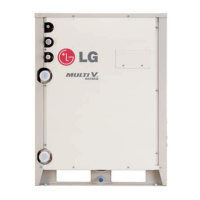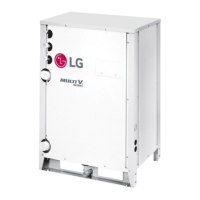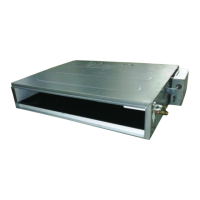78
MULTI V Water IV System Installation Manual
Due to our policy of continuous product innovation, some specifications may change without notification.
©LG Electronics U.S.A., Inc., Englewood Cliffs, NJ. All rights reserved. “LG” is a registered trademark of LG Corp.
WATER CIRCUIT INSTALLATION
Freeze Protection
Protect the water piping system from freezing during winter conditions. When the water source unit is in heating mode, the water loop
temperature is reduced and there is risk of slush forming and / or the loop water freezing. In applications with leaving water temperatures
below 40°F, freeze protection should be considered. Use of ethylene glycol, propylene glycol, or methanol is acceptable. Table 60 shows
recommended levels of antifreeze concentration; however, the addition of antifreeze may lower performance of the water source unit due to
reduced heat transfer and added pressure drop. Figure 62 and Figure 63 are graphic representations of the data in Table 60.
The calculations below require the nominal capacity and the nominal pressure drop of the appropriate model(s) of WSU. Refer to the General
Data Tables beginning on page 9 for these values. To determine the effect of adding antifreeze on WSU performance, calculate the net
capacity and the net pressure drop as follows:
WSU Net Capacity due to Antifreeze
1. Refer to Table 60 and locate the type of antifreeze used and the percentage by weight of the antifreeze in the water piping system.
2. Cross-index the cooling (or heating) row with the percentage by weight column to nd the cooling (or heating) correction factor.
3. Multiply the WSU nominal capacity by the cooling (or heating) correction factor. The result is the net capacity due to the effect of antifreeze.
WSU Net Pressure Drop due to Antifreeze
1. Refer to Table 60 and locate the type of antifreeze used and the percentage by weight of the antifreeze in the water piping system.
2. Cross-index the pressure drop row with the percentage by weight column to find the pressure drop correction factor.
3. Multiply the WSU nominal pressure drop by the pressure drop correction factor. The result is the net pressure drop due to the effect of
antifreeze.
Table 60: Antifreeze Capacity Correction Factors.
Piping System Specications
Antifreeze Type Item
Antifreeze Percentage by Weight
10% 20% 30% 40% 50%
Methanol
Cooling 0.998 0.997 0.995 0.993 0.992
Heating 0.995 0.99 0.995 0.979 0.974
Pressure Drop 1.023 1.057 1.091 1.122 1.160
Ethylene Glycol
Cooling 0.996 0.991 0.987 0.983 0.979
Heating 0.993 0.985 0.997 0.969 0.961
Pressure Drop 1.024 1.068 1.124 1.188 1.263
Propylene Glycol
Cooling 0.993 0.987 0.98 0.974 0.968
Heating 0.986 0.973 0.96 0.948 0.935
Pressure Drop 1.040 1.098 1.174 1.273 1.405
Figure 62: Cooling Capacity Correction Factor Chart. Figure 63: Heating Capacity Correction Factor Chart.
Antifreeze % by wt
0% 10% 20% 30% 40% 50%
1.000
0.990
0.980
0.970
0.960
0.950
0.940
0.930
Methanol
Ethylene glycol
Propylene glycol
Antifreeze % by wt
0% 10% 20% 30% 40% 50%
1.000
0.990
0.980
0.970
0.960
0.950
0.940
0.930
Methanol
Ethylene glycol
Propylene glycol

